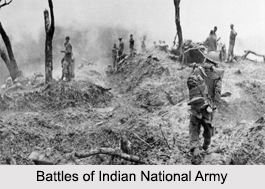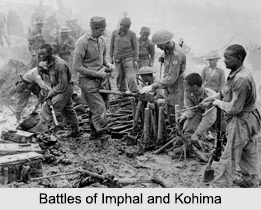 Battles of Indian National Army were targeted against the British at large. Indian National Army was involved in many battles and operations under the leadership of Subhash Chandra Bose. INA had two phases; the first phase of INA led by Capt. Mohan Singh suffered a lot. Indian National Army in its first phase was not considered a significant military threat by the British, yet, it was deemed a significant strategic threat especially to the Indian Army. It was not considered to be a substantial force or have any purpose more than propaganda and espionage purposes. The strategy of INA was to avoid battles because it lacked arms, armament as well as man-power. The whole scenario changed in the second phase of INA, after its revival by Subhas Chandra Bose. Indian National Army had planned that once the Japanese forces were able to break the British defences at Imphal, it would cross the hills of North-East India into the Gangetic plain. Moreover, INA aimed to ensure that Britain would not be in a position to re-assert its colonial authority again.
Battles of Indian National Army were targeted against the British at large. Indian National Army was involved in many battles and operations under the leadership of Subhash Chandra Bose. INA had two phases; the first phase of INA led by Capt. Mohan Singh suffered a lot. Indian National Army in its first phase was not considered a significant military threat by the British, yet, it was deemed a significant strategic threat especially to the Indian Army. It was not considered to be a substantial force or have any purpose more than propaganda and espionage purposes. The strategy of INA was to avoid battles because it lacked arms, armament as well as man-power. The whole scenario changed in the second phase of INA, after its revival by Subhas Chandra Bose. Indian National Army had planned that once the Japanese forces were able to break the British defences at Imphal, it would cross the hills of North-East India into the Gangetic plain. Moreover, INA aimed to ensure that Britain would not be in a position to re-assert its colonial authority again.
The Indian National Army under the leadership of Netaji, along with its allies, the Japanese advanced against the armies of Great Britain. The main aim and slogan of INA was "Chalo Delhi". Thus, on 23 October the Azad Hind Government declared war against Britain and the United States. In order to achieve its aim, INA fought some of the violent battles on the battlefields of Manipur, Imphal, Nagaland, Kohima and Red Hill. The strategy of the Battles of Indian National Army was so designed that the troops eventually reached India and hoisted the Tricolour for the first time. The Tricolour was hoisted in the Indian soil in Moirang, Manipur. The Provisional Government of Azad Hind was established at Andaman and Nicobar Islands and Kohima.
Subhas Chandra Bose with INA started his journey to free India after the intensive military training of armies. He planned to enter north-east India through Burma. The INA, together with the Japanese, successfully staged two military campaigns in March and captured Imphal and Arakan. The Japanese forces began its attacks on India`s eastern frontier in March 1944. Three divisions were created from Kawabe`s Burma Area Army to initiate a diversionary attack at Arakan and cover the southern coast. On the other hand another two divisions watched Stillwell and Chiang Kai Shek`s forces in the north. Furthermore, three divisions were pushed into Manipur to capture Imphal. This action scattered British forces and prevented any offensive movements against Burma. The Special Services Group of INA called "Bahadur Group" worked with the advanced Japanese units in the upper Burma region and into Manipur. A unit of the Bahadur Group, led by Col. Shaukat Malik, busted through the British defences on 18 April 1944 to capture Moirang in Manipur. Consequently, the Azad Hind administration took control of this independent Indian Territory.
The battles of Indian National Army continued with the 1st battalion of the INA, first Guerrilla regiment. They were directed towards the south to participate in the diversionary attack. The unit journeyed from Rangoon to Prome and marched across the Chin Hills to reach the Taungup and then to Akyab. In this operation, though the attak from diversion was successful, yet INA failed to capture and destroy Messervy`s 17th Indian Division. The 1st battalion marched up the Kaladan River and approached Kyauktaw, east of Mayu peninsula. As the battle progressed, it engaged the commonwealth forces at Kohima. The main force detailed to engage Imphal was to approach from the south-east via the Tamu Road. The INA`s four guerrilla regiments were directed to Tamu road and detailed to push into India as Imphal falls.
 The 2nd and 3rd battalions which were led by Col. Shah Nawaz Khan crossed the Chindwin at Kalewa. However, the offensive was subsequently stopped for the fierce resistance experienced from the commonwealth forces. The forces led by Khan were redirected to engage Kohima. The major event related to the Battles of Indian National Army was the Burma Campaign. The Burma Campaign was fought between British Commonwealth, Chinese and United States forces against the forces of the Empire of Japan, Thailand, the Burmese Independence Army and the Indian National Army. The campaign had certain distinguished features. The INA had to face major crisis that included acute shortages of supply of food, ammunition and medicine. To make situation worse, the crisis situation was intensified by the Monsoon rains. Added to that disease, compounded poor sanitation and inability to evacuate the worse-affected due to a lack of transport were the major factors that stroked INA as well as the Japanese troops.
The 2nd and 3rd battalions which were led by Col. Shah Nawaz Khan crossed the Chindwin at Kalewa. However, the offensive was subsequently stopped for the fierce resistance experienced from the commonwealth forces. The forces led by Khan were redirected to engage Kohima. The major event related to the Battles of Indian National Army was the Burma Campaign. The Burma Campaign was fought between British Commonwealth, Chinese and United States forces against the forces of the Empire of Japan, Thailand, the Burmese Independence Army and the Indian National Army. The campaign had certain distinguished features. The INA had to face major crisis that included acute shortages of supply of food, ammunition and medicine. To make situation worse, the crisis situation was intensified by the Monsoon rains. Added to that disease, compounded poor sanitation and inability to evacuate the worse-affected due to a lack of transport were the major factors that stroked INA as well as the Japanese troops.
INA however did not lose its morale after the crisis faced during Burma Campaign. Yet it continued preparing vigorously for its defence. The parallel Battle of Meiktila and Battle of Mandalay were decisive battles which brought the end of the Burma Campaign. Burma finally prepared to surrender; Bose`s government had withdrawn from Rangoon along with the Japanese forces and Ba Maw`s government. The Rani of Jhansi troops began a long march through Burma to reach Singapore. The other major Battles of Indian National Army included fights of the Irrawaddy at Nyaungu and Bagan, where INA had to face major challenges. Its ally, the Japanese army lost and withdrew from the banks of the Irrawaddy line. Delhi started going out of our reach. INA had practically lost the War. Despite the loss of an ally, Netaji did not hesitate. He immediately looked to the Soviet Union for support. He had hoped to carry out the military Campaign in early 1945. However, on 18 August 1945, Netaji`s plane crashed while en route to the Soviet Union via Taiwan. Furthermore, after the atomic attack on Hiroshima and Nagasaki, Japan surrendered in August 1945 and so did the INA.
The INA fought many heroic battles against the superior British forces. The civilian volunteers of the Indian National Army showed their mettle and were equal in bravery and courage. Though it was small in size and faced crises of lack of heavy weapons yet it tried fighting the British. Lack of independent planning and death of Netaji were considered the major causes for the failure of INA.



















